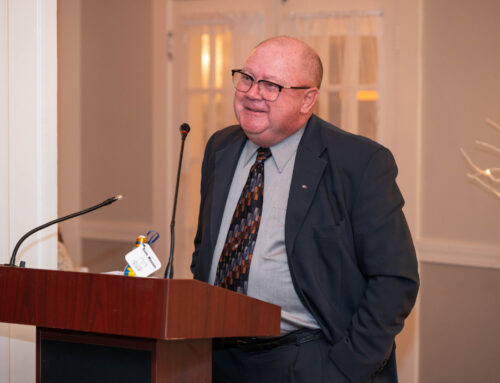
The Penobscot River was once a bustling waterway, bringing millions of migratory fish from the Gulf of Maine to distant spawning grounds nestled in the lakes and streams of the Appalachian Mountains. With the advent of industrialization, over 100 dams were erected along the river and pollution tainted the waters, leading to a dramatic decline in the fish populations. The Danforth Fishway Project is one effort to help restore the Penobscot River to its former glory by enabling fish to regain their migration path. Led by the Atlantic Salmon Federation, this initiative aims to reopen access to nearly 8,960 acres and 137 miles of stream habitat for alewives and other migratory fish species by constructing a pool and weir fishway at the Baskahegan Dam. Utilizing a special drill rig and working with ten partner organizations, N.S. Giles, a self-performing concrete construction company, completed the over $1 million project in four months. This project is part of a collaborative 30-year endeavor involving federal, state, tribal, and non-governmental organizations to revitalize the Penobscot watershed. For the team at N.S. Giles, it was an incredibly rewarding opportunity to work on a project that benefited both their community and the environment.
CONTRIBUTION TO COMMUNITY
This project will improve the health of the Penobscot River, a benefit to the local community as well as nature enthusiasts, avid fishermen, and outdoorsmen. The Danforth Fishway Project also directly impacts the Penobscot Nation. For the Penobscot people, who have inhabited the river’s banks for millenia, the river was not just a waterway, but a vital lifeline. Fish were an integral part of Penobscot people’s sustenance, comprising a third of their diet, and regularly utilized as garden fertilizer. Before the river was dammed, the watershed teemed with Atlantic salmon, herring, and American Shad. Industrialization led to a dramatic decline in fish populations and the Penobscot Nation’s last ceremonial harvest of Atlantic salmon occurred in 1988. Concerns about contamination of the remaining fish led to dietary shifts for the Penobscot people, with processed food becoming more prevalent and thus diabetes becoming more common. Worse, the erosion of ancestral customs has inflicted profound psychological wounds on the Penobscot Nation. “In losing aspects of our culture, we’ve also lost part of ourselves,” laments Chuck Loring, Jr., the Penobscot Nation’s Director of Natural Resources. “The river was our highway and our food source.” The Danforth Fishway Project will help create a revitalized watershed and healthy fish population, providing an opportunity for the Penboscot to once again connect with the river in ways that support their culture.
ENVIRONMENT
The Danforth Fishway Project, by helping to establish a self-sustaining alewife run, will have broad ecological, social, and economic benefits for the entire Penobscot watershed, extending from Penobscot Bay to the Gulf of Maine. Over the past four years, alewives have been spotted at the base of the Baskahegan Dam for the first time in two centuries.
Back in 2009, the Gulf of Maine Atlantic Salmon population was designated as endangered by both NOAA Fisheries and the U.S. Fish and Wildlife Service. A comprehensive strategy to restore and remove species from the endangered list was put together in 2020 and has spurred collaborative efforts to restore the Penobscot watershed. The Danforth Fishway is part of this effort and will support the revitalization of the Atlantic salmon population. Last year, the Maine Department of Marine Resources reported a count of 1,520 Atlantic salmon on the Penobscot River, the highest tally recorded in over a decade. The endeavor to revive the Atlantic salmon population has also yielded a remarkable resurgence in river herring numbers. River herring serve as a keystone species, or an organism that helps define and enhance an entire ecosystem, and are an important food source for animals ranging from osprey to whales. Abundant river herring populations also protect juvenile salmon, shielding them from predators such as bald eagles and striped bass. The project also ensures the preservation of vital inland wading bird and waterfowl habitat.

CHALLENGES & SAFETY
Having a job site on a river with fast-moving water presented several challenges for the N.S. Giles crew. The weather proved difficult at times; on top of an historically wet year, Hurricane Lee struck two weeks after the project commenced, completely flooding the site and delaying the project for close to four weeks. Wes O’Hara, N.S. Giles Foreman, met with the engineer of record every Tuesday to ensure the project continued on the right track.
The job site itself also presented safety hazards. The N.S. Giles team took the time to research how to create the safest work environment possible. They created water rescue plans and paired them with site-specific rescue plans. Since cell phone service was not available at the job site, the team had to be well trained and prepared for any incident or rescue scenario. The N.S. Giles team worked 5,785.44 man hours with zero lost time injuries.
View the project video here – https://youtu.be/enWmyvrMdBM

Project Title: Danforth Fishway-Baskahegan Lake and Crooked Dam
Owner: Atlantic Salmon Federation
Construction Manager: N.S. Giles
- Wes O’Hara, Foreman
General Contractor: Sargent Corporation
Engineer: Acadia Civil Works
- Joseph M. McLean, PE
Key Partners:
- Atlantic Salmon Federation
- Maranda Nemeth, Maine Headwaters Project Manager
- Penobscot Nation
- American Rivers
- Maine Audubon
- Natural Resources Council of Maine
- The Nature Conservancy
- Trout Unlimited
- S. Fish and Wildlife Service
- State of Maine


